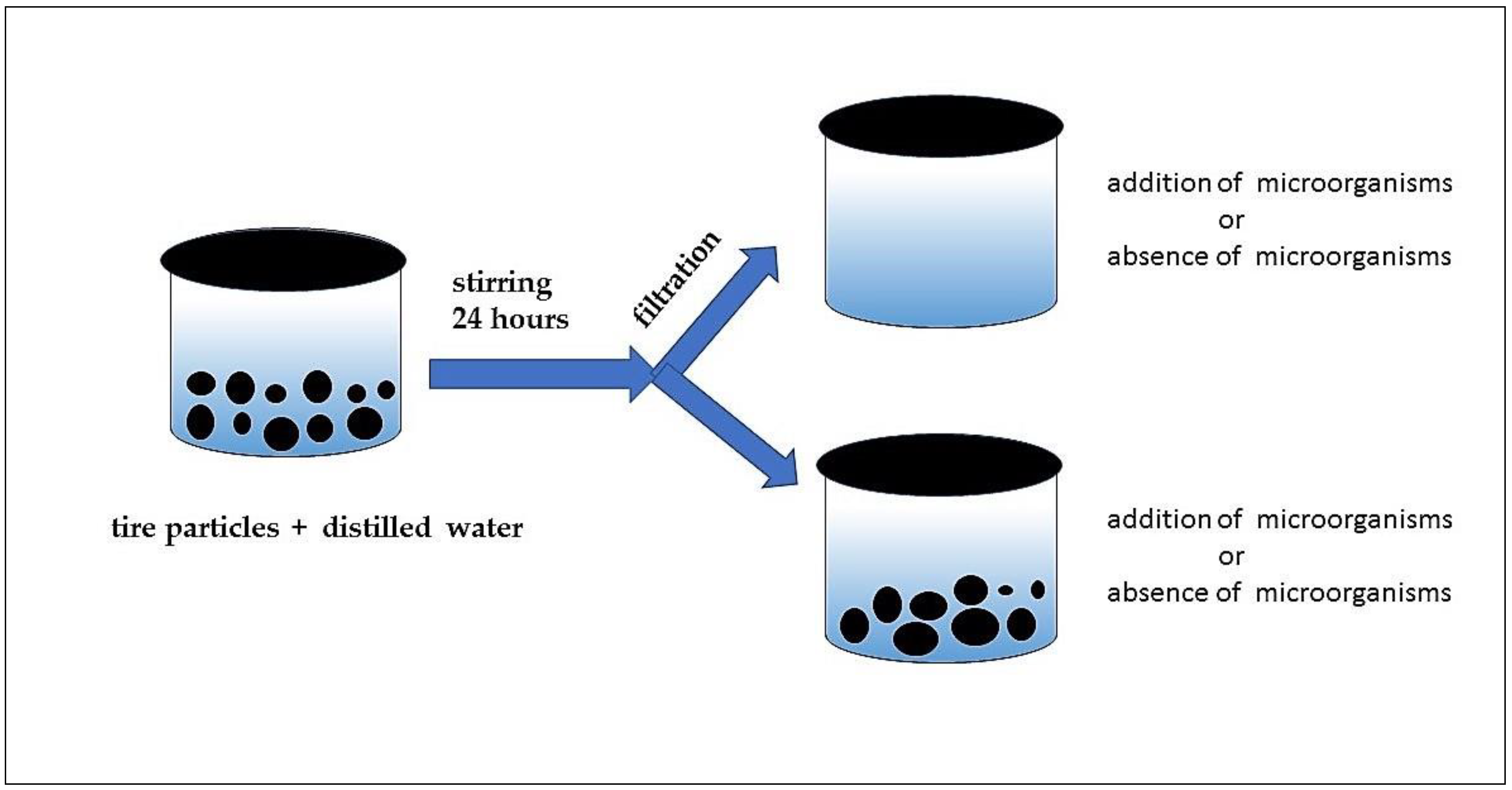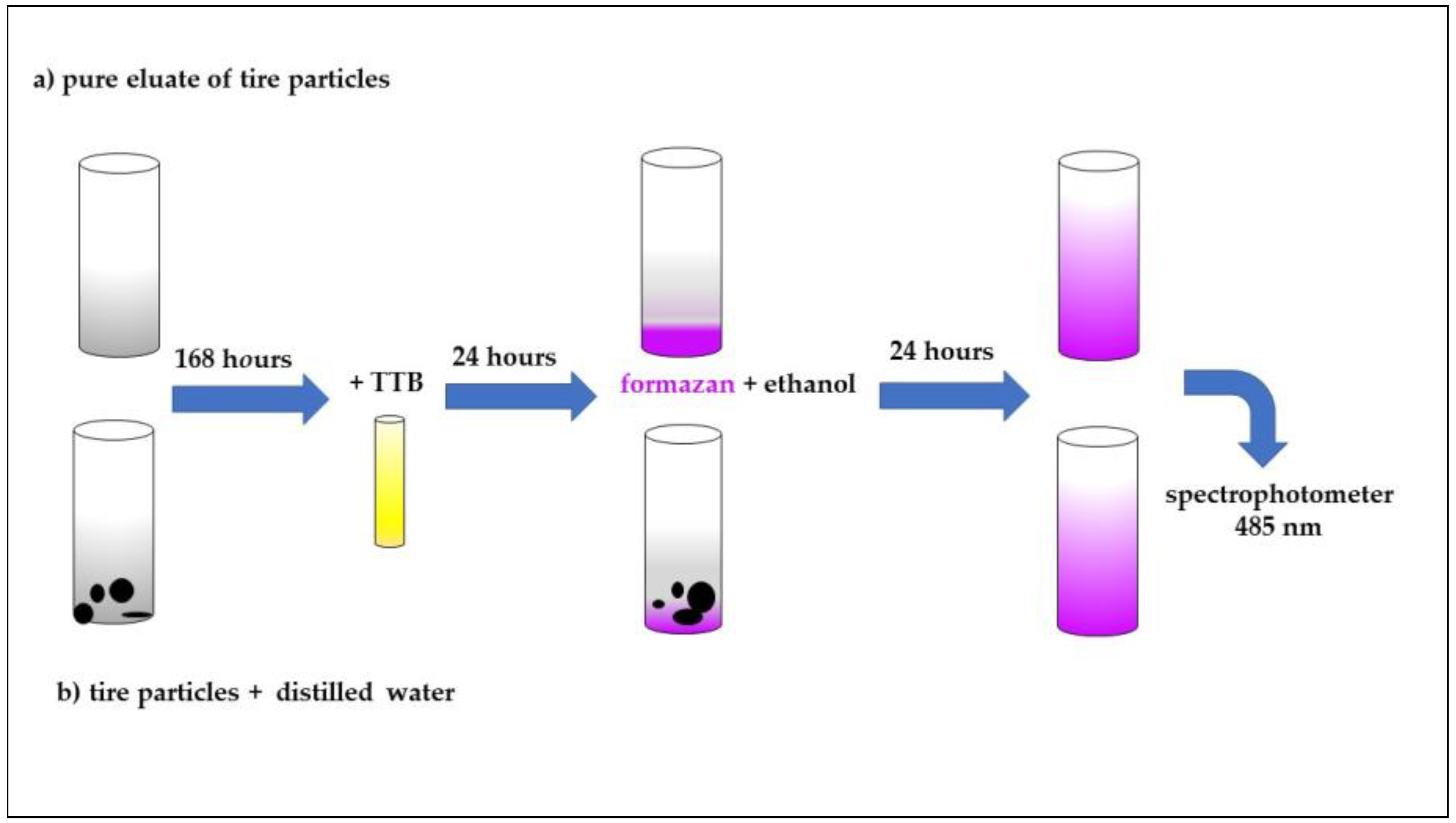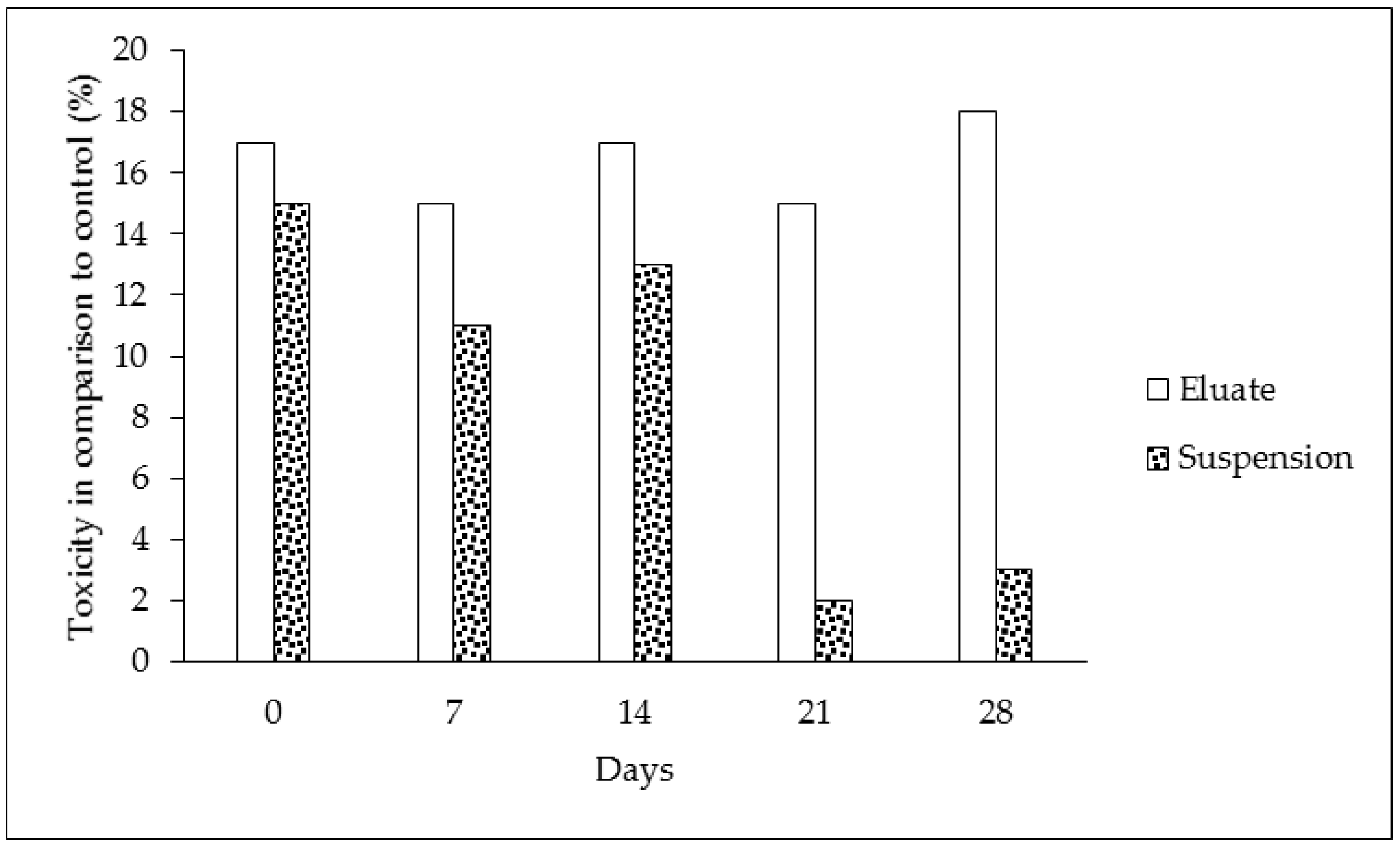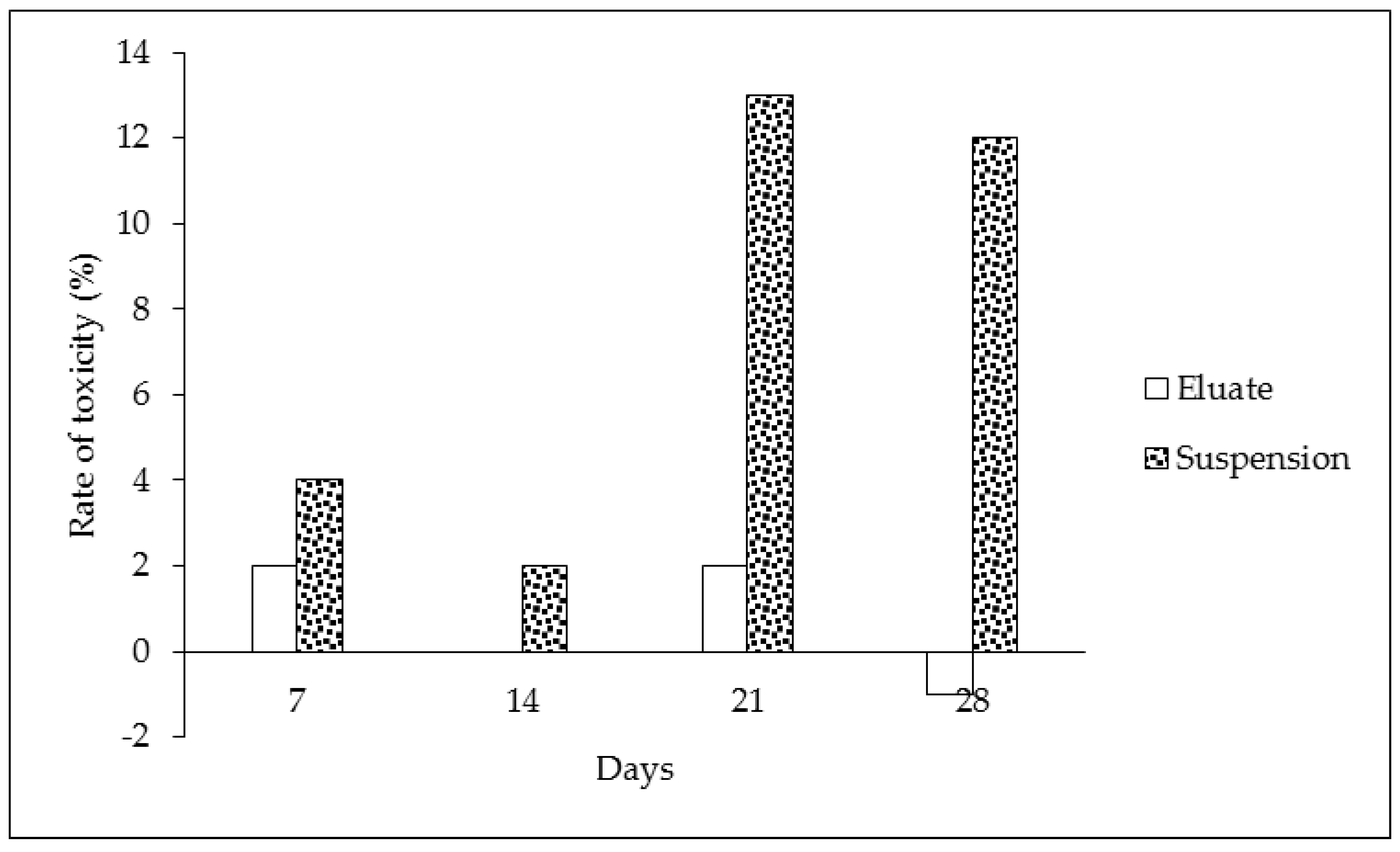Toxic and Biodegradation Potential of Waste Tires for Microorganisms Based on Two Experimental Designs
Abstract
1. Introduction
2. Materials and Methods
Viability MTT Assay
3. Results and Discussion
4. Conclusions
- Waste tires from transport were tested in biodegradation and toxicological experiments with a nonspecific soil microbial community in the present study. The results showed various toxicities but no biodegradation of the waste tires during 28 days of exposure.
- Higher toxicity was found during the respiration inhibition test as well as for the viability assay in the case of suspensions with tire particles than for pure eluates. Such results raise the question of whether such an experimental design should always be used when tests are performed using solid sample leachates, or if both variants should be used together in one experimental design for a more ecologically relevant and realistic comparison.
- The viability tests represented an acute toxic effect and the respiration inhibition test a chronic effect. However, we compared the results from the period of 168 h, and we found that the microorganisms were more sensitive in the short viability test than in the chronic test during the course of 168 h. A similar comparison has never been studied in ecotoxicological papers and as such we are not able to review and discuss these types of results.
- The non-degradability of compounds in the waste eluates indicated that the leachates from waste tires were not subject to degradation. These results were also strongly influenced by a short-term experiment (a duration of only 28 days). Unfortunately, this confirmed the problematic removal of waste tires, which do not undergo environmental degradation. Therefore, the negative ecotoxicological results on soil and aquatic organisms, together with the large leaching of heavy metals or organic pollutants and limited biodegradation, lead to the conclusion that waste tire particles are not a harmless material and their possible use and processing with various techniques needs to be further investigated.
- Other microorganismal or sub-cellular assays should be used for the assessment of toxicity and biodegradability of rubber tires in the future. Another possibility is the use of multi-generation or multi-species tests or in microcosms or mesocosms in aquatic or terrestrial environments. Different species or types of microorganisms should be used as model organisms—mainly yeasts, bacteria, green or blue algae, molds, fungi and their mixtures.
- The practical significance of the conducted research lies in the knowledge that both types of methodologies (eluates + suspension of solid tested particles) are supposed to be used simultaneously. This finding should be reflected in the methodologies used for legislative purposes in the determination of ecotoxicity for microbial communities.
Author Contributions
Funding
Institutional Review Board Statement
Informed Consent Statement
Data Availability Statement
Conflicts of Interest
References
- Gome, F.B.; Rocha, M.R.; Alves, A.; Ratola, N. A review of potentially harmful chemicals in crumb rubber used in synthetic football pitches. J. Hazard. Mater. 2021, 409, 124998. [Google Scholar] [CrossRef] [PubMed]
- Ferdous, W.; Manalo, A.; Siddique, R.; Mendis, P.; Yan, Z.G.; Wong, H.S.; Lokuge, W.; Aravinthan, T.; Schubel, P. Recycling of landfill wastes (tyres, plastics and glass) in construction—A review on global waste generation, performance, application and future opportunities. Resour. Conserv. Recycl. 2021, 173, 105745. [Google Scholar] [CrossRef]
- Sibeko, M.A.; Adeniji, A.O.; Okoh, O.O.; Hlangothi, S.P. Trends in the management of waste tyres and recent experimental approaches in the analysis of polycyclic aromatic hydrocarbons (PAHs) from rubber crumbs. Environ. Sci. Pollut. Res. 2020, 27, 43553–43568. [Google Scholar] [CrossRef] [PubMed]
- Landi, D.; Gigli, S.; Germani, M.; Marconi, M. Investigating the feasibility of a reuse scenario for textile fibers recovered from end-of-life tyres. Waste Manag. 2018, 75, 187–204. [Google Scholar] [CrossRef]
- Strukar, K.; Sipos, T.K.; Milicevic, L.; Busic, R. Performance of rubber mortars containing silica coated rubber. Eng. Struct. 2019, 188, 452–468. [Google Scholar] [CrossRef]
- Wang, J.Q.; Du, B. Experimental studies of thermal and acoustic properties of recycled aggregate crumb rubber concrete. J. Build. Eng. 2020, 32, 101836. [Google Scholar] [CrossRef]
- De Vries, M.; Claassen, L.; Mennen, M.; Timen, A.; Wierik, M.J.M.; Timmermans, D.R.M. Public perceptions of contentious risk: The case of rubber granulate in the Netherlands. Int. J. Environ. Res. Public Health 2019, 16, 2250. [Google Scholar] [CrossRef]
- Skoczynska, E.; Leonards, P.E.G.; Lompart, M.; de Boer, J. Analysis of recycled rubber: Development of an analytical method and determination of polycyclic aromatic hydrocarbons and heterocyclic aromatic compounds in rubber matrices. Chemosphere 2021, 276, 130076. [Google Scholar] [CrossRef]
- Xu, Y.Y.; Karedal, M.; Nielsen, J.; Adlercreutz, M.; Bergendorf, U.; Strandberg, B.; Antonsson, A.B.; Tinnerberg, H.; Albin, M. Exposure, respiratory symptoms, lung function and inflammation response of road-paving asphalt workers. Occup. Environ. Med. 2018, 75, 494–500. [Google Scholar] [CrossRef]
- Diekmann, A.; Giese, U.; Schaumann, I. Polycyclic aromatic hydrocarbons in consumer goods made from recycled rubber material: A review. Chemosphere 2019, 220, 1163–1178. [Google Scholar] [CrossRef]
- Perkins, B.N.; Inayat-Hussain, S.H.; Deziel, N.C.; Johnson, C.H.; Ferguson, S.S.; Garcia-Milian, R.; Thompson, D.C.; Vasiliou, V. Evaluation of potential carcinogenicity of organic chemicals in synthetic turf crumb rubber. Environ. Res. 2019, 169, 163–172. [Google Scholar] [CrossRef] [PubMed]
- Canepari, S.; Castellano, P.; Astolfi, M.L.; Materazzi, S.; Ferrante, R.; Fiorini, D.; Curini, R. Environ. Biomonitoring of element contamination in bees and beehive products in the Rome province (Italy). Sci. Pollut. Res. 2018, 25, 1448–1459. [Google Scholar] [CrossRef]
- Brandsma, S.H.; Brits, M.; Groenewoud, Q.R.; van Velzen, M.J.M.; Leonards, P.E.G.; de Boert, J. Environ. Chlorinated Paraffins in Car Tires Recycled to Rubber Granulates and Playground Tiles. Sci. Technol. 2019, 53, 7595–7603. [Google Scholar] [CrossRef] [PubMed]
- Peterson, M.K.; Lemay, J.C.; Shubin, S.P.; Prueitt, R.L. Comprehensive multipathway risk assessment of chemicals associated with recycled (“crumb”) rubber in synthetic turf fields. Environ. Res. 2018, 160, 256–268. [Google Scholar] [CrossRef]
- Schneider, K.; Bierwisch, A.; Kaiser, E. ERASSTRI—European risk assessment study on synthetic turf rubber infill—Part 3: Exposure and risk characterisation. Sci. Total Environ. 2020, 718, 9. [Google Scholar] [CrossRef] [PubMed]
- Menichini, E.; Abate, V.; Attias, L.; De Luca, S.; Di Domenico, A.; Fochi, I.; Forte, G.; Iacovella, N.; Iamiceli, A.L.; Izzo, P.; et al. Artificial-turf playing fields: Contents of metals, PAHs, PCBs, PCDDs and PCDFs, inhalation exposure to PAHs and related preliminary risk assessment. Sci. Total Environ. 2011, 409, 4950–4957. [Google Scholar] [CrossRef]
- Kruger, O.; Kalbe, U.; Richter, E.; Egeler, P.; Römbke, J.; Berger, W. New approach to the ecotoxicological risk assessment of artificial outdoor sporting grounds. Environ. Pollut. 2013, 175, 69–74. [Google Scholar] [CrossRef]
- Khan, F.R.; Halle, L.L.; Palmquist, A. Acute and long-term toxicity of micronized car tire wear particles to Hyalella azteca. Aquat. Toxicol. 2019, 213, 105216. [Google Scholar] [CrossRef]
- Kobetičová, K.; Fořt, J.; Böhm, M.; Nábělková, J.; Černý, R. Verification of ecological safety of waste tires. Waste Forum 2020, 2, 73–77. [Google Scholar]
- Fořt, J.; Kobetičová, K.; Böhm, M.; Podlesný, J.; Jelínková, V.; Vachtlová, M.; Bureš, F.; Černý, R. Environmental Consequences of Rubber Crumb Application: Soil and Water Pollution. Polymers 2022, 14, 1416. [Google Scholar] [CrossRef]
- Burges, A.; Alkorta, I.; Epelde, L.; Garbisu, C. From phytoremediation of soil contaminants to phytomanagement of ecosystem services in metal contaminated sites. Int. J. Phytoremediat. 2018, 20, 384–397. [Google Scholar] [CrossRef] [PubMed]
- Ebrahimbabaie, P.; Meeinkuirt, W.; Pichtel, J. Phytoremediation of engineered nanoparticles using aquatic plants: Mechanisms and practical feasibility. J. Environ. Sci. 2020, 93, 151–163. [Google Scholar] [CrossRef] [PubMed]
- Emenike, C.U.; Jayanthi, B.; Agamuthu, P.; Fauziah, S.H. Biotransformation and removal of heavy metals. Environ. Rev. 2018, 26, 156–168. [Google Scholar] [CrossRef]
- Malik, A.; Khan, J.M.; Alhomida, A.S.; Ola, M.S.; Alshehri, M.A.; Ahmad, A. Metal nanoparticles: Biomedical applications and their molecular mechanisms of toxicity. Chem. Pap. 2022, 76, 6073–6095. [Google Scholar] [CrossRef]
- Facciola, A.; Visalli, G.; Ciarello, M.P.; Di Pietro, A. Newly Emerging Airborne Pollutants: Current Knowledge of Health Impact of Micro and Nanoplastics. Int. J. Environ. Res. Public Health 2021, 18, 2997. [Google Scholar] [CrossRef] [PubMed]
- Panver, R.; Mathur, J. Remediation of polycyclic aromatic hydrocarbon-contaminated soils using microbes and nanoparticles: A review. Pedosphere 2023, 33, 93–104. [Google Scholar]
- Singha, L.P.; Pandey, P. Rhizosphere assisted bioengineering approaches for the mitigation of petroleum hydrocarbons contamination in soil. Crit. Rev. Biotechnol. 2021, 41, 749–766. [Google Scholar] [CrossRef]
- Singh, S.K.; Sachan, A. A review on biotransformation of polyaromatic hydrocarbons mediated by biosurfactant producing bacteria. Pet. Sci. Technol. 2021, 40, 2361–2381. [Google Scholar] [CrossRef]
- Ismail, N.A.; Kasmuri, N.; Hamzah, N. Microbial Bioremediation Techniques for Polycyclic Aromatic Hydrocarbon (PAHs)-a Review. Water Air Soil Pollut. 2022, 233, 144. [Google Scholar] [CrossRef]
- Sakshi; Haritash, A.K. A comprehensive review of metabolic and genomic aspects of PAH-degradation. Arch. Microbiol. 2020, 202, 2033–2058. [Google Scholar] [CrossRef]
- OECD Guideline for Testing of Chemicals, Available 3rd April 2023 Online: Test No. 209: Activated Sludge, Respiration Inhibition Test (Carbon and Ammonium Oxidation). 2010. Available online: https://www.oecd.org/env/test-no-209-activated-sludge-respiration-inhibition-test-9789264070080-en.html (accessed on 15 February 2023).
- Benov, L. Improved Formazan Dissolution for Bacterial MTT Assay. Microbiol. Spectr. 2021, 9, 0163721. [Google Scholar] [CrossRef] [PubMed]
- Plumb, J.A.; Milroy, R.; Kaye, S.B. Effects of the pH dependence of 3-(4,5-dimethylthiazol-2-yl)-2,5-diphenyl-tetrazolium bromide-formazan absorption on chemosensitivity determined by a novel tetrazolium-based assay. Cancer Res. 1989, 49, 4435–4440. [Google Scholar] [PubMed]
- Wang, H.; Wang, F.; Tao, X.; Cheng, H. Ammonia-containing dimethyl sulfoxide: An improved solvent for the dissolution of formazan crystals in the 3-(4,5-dimethylthiazol-2-yl)-2,5-diphenyl tetrazolium bromide (MTT) assay. Anal. Biochem. 2012, 421, 324–326. [Google Scholar] [CrossRef] [PubMed]
- Twentyman, P.R.; Luscombe, M.B. A study of some variables in a tetrazolium dye (MTT) based assay for cell growth and chemosensitivity. J. Cancer 1987, 56, 279–285. [Google Scholar] [CrossRef] [PubMed]
- Thakare, A.A.; Gupta, T.; Deewan, R.; Chaudhary, S. Micro and macro-structural properties of waste tyre rubber fibre-reinforced bacterial self-healing mortar. Constr. Build. Mater. 2022, 322, 126459. [Google Scholar] [CrossRef]
- Stockert, J.C.; Horobin, R.W.; Colombo, L.L.; Blázquez-Castro, A. Tetrazolium salts and formazan products in Cell Biology: Viability assessment, fluorescence imaging, and labeling perspectives. Acta Histochem. 2018, 120, 159–167. [Google Scholar] [CrossRef]
- OECD Guideline for Testing of Chemicals, Available 27th February 2023. Available online: https://www.oecd.org/chemicalsafety/testing/TG%20491_Draft%20updated%20Sept%202019_clean.pdf (accessed on 15 February 2023).
- Mosmann, T. Rapid colorimetric assay for cellular growth and survival: Application to proliferation and cytotoxicity assays. J. Immunol. Methods 1983, 65, 55–63. [Google Scholar] [CrossRef]
- Berridge, M.V.; Herst, P.M.; Tan, A.S. Tetrazolium dyes as tool since ll biology: New insights in to the ircellular reduction. Biotechnol. Annu. Rev. 2005, 11, 127–152. [Google Scholar]
- Porzani, S.; Lima, S.T.; Metcalf, J.S.; Nowruzi, B. In Vivo and In Vitro Toxicity Testing of Cyanobacterial Toxins: A Mini-Review. Rev. Environ. Contam. Toxicol. 2021, 258, 109–150. [Google Scholar]
- Handali, S.; Rezaei, M. Interlink between improved formulations, inhibitory concentrations and cell death mechanism investigations of cytotoxic drugs: What really matters? J. Control. Release 2020, 320, 404–411. [Google Scholar] [CrossRef]
- Da Luz, D.S.; Da Silva, D.G.; Souza, M.M.; Giroldo, D.; Gaspar, M.C.D.G. Efficiency of Neutral Red, Evans Blue and MTT to assess viability of the freshwater microalgae Desmodesmus communis and Pediastrum boryanum. Phycol. Res. 2016, 24, 56–60. [Google Scholar] [CrossRef]
- Isa, H.W.M.; Johari, W.L.W.; Syahir, A.; Abd Shukor, M.Y.; Azwady, A.A.N.; Shaharuddin, N.A.; Muskhazli, M. Development of a Bacterial-based Tetrazolium Dye (MTT) Assay for Monitoring of Heavy Metals. Int. J. Agric. Biol. Eng. 2014, 16, 1123–1128. [Google Scholar]
- Halmi, M.I.E.; Ahmad, F.; Hashim, A.K.; Shamaan, N.A.; Syed, M.A.; Shukor, M.Y. Effect of bacterial growth period on the sensitivity of the MTT assay for silver. J. Environ. Biol. 2014, 35, 353–355. [Google Scholar] [PubMed]
- Pilgard, A.; De Vetter, L.; Van Acker, J.; Westin, M. Toxic hazard of leachates from furfurylated wood: Comparison between two different aquatic organisms. Environ. Toxicol. Chem. 2010, 29, 1067–1071. [Google Scholar] [CrossRef] [PubMed]
- Wilk, B.K.; Szopinska, M.; Sobaszek, M.; Pierpaoli, M.; Blaszczyk, A.; Luczkiewicz, A.; Fudala-Ksiazek, S. Electrochemical oxidation of landfill leachate using boron-doped diamond anodes: Pollution degradation rate, energy efficiency and toxicity assessment. Environ. Sci. Pollut. Res. 2022, 29, 65625–65641. [Google Scholar] [CrossRef]
- Zhou, Y.; Wang, F.H.; Wan, J.; He, J.; Li, Q.; Chen, Q.; Gao, J.; Lin, Y.; Zhang, S. Ecotoxicological bioassays of sediment leachates in a river bed flanked by decommissioned pesticide plants in Nantong City, East China. Environ. Sci. Pollut. Res. 2017, 24, 8541–8550. [Google Scholar] [CrossRef]
- Baysal, A.; Saygin, H.; Ustabasi, G.S. Impact of test conditions on the bacterial bioassay in the presence of TiO2 nanoparticles. J. Chem. Metrol. 2021, 14, 114–124. [Google Scholar] [CrossRef]
- Malara, A.; Oleszczuk, P. Application of a battery of biotests for the determination of leachate toxicity to bacteria and invertebrates from sewage sludge-amended soil. Environ. Sci. Pollut. Res. 2013, 20, 3435–3446. [Google Scholar] [CrossRef]
- Böhm, M.; Kobetičová, K.; Fořt, J.; Černý, R. Determination of metals leakage from rubber granulate. AIP Conf. Proc. 2022, 2425, 150003. [Google Scholar]
- McCarrick, S.; Cunha, V.; Zapletal, O.; Vondracek, J.; Dreij, K. In vitro and in vivo genotoxicity of oxygenated polycyclic aromatic hydrocarbons. Environ. Pollut. 2019, 246, 678–687. [Google Scholar] [CrossRef]
- Toyooka, T.; Ibuki, Y. DNA damage induced by coexposure to PAHs and light. Environ. Toxicol. Pharmacol. 2007, 23, 256–263. [Google Scholar] [CrossRef] [PubMed]
- He, J.; Pang, Q.; Huang, C.M.; Xie, J.; Hu, J.; Wang, L.; Wang, C.C.; Meng, L.; Fan, R. Environmental dose of 16 priority-controlled PAHs mixture induce damages of vascular endothelial cells involved in oxidative stress and inflammation. Toxicol. In Vitro 2022, 79, 105296. [Google Scholar] [CrossRef] [PubMed]
- Misaki, K.; Matsui, S.; Matsuda, T. Metabolic enzyme induction by HepG2 cells exposed to oxygenated and nonoxygenated polycyclic aromatic hydrocarbons. Chem. Res. Toxicol. 2007, 20, 277–283. [Google Scholar] [CrossRef] [PubMed]
- Kanwal, N.; Shah, A.A.; Qayyum, S.; Hasan, F. Optimization of pH and temperature for degradation of tyre rubber by Bacillus sp. strain S10 isolated from sewage sludge. Int. Biodeterior. Biodegrad. 2015, 103, 154–160. [Google Scholar] [CrossRef]
- Tsuchii, A.; Takeda, K.; Tokiwa, Y. Degradation of the rubber in truck tires by a strain of Nocardia. Biodegradation 1997, 7, 405–413. [Google Scholar] [CrossRef]




| Sample (No. of Repetition) | 0 Time | 7th Day | 14th Day | 21st Day | 28th Day |
|---|---|---|---|---|---|
| (A) The control medium with microorganisms | |||||
| Control (1) + inoculum | 5.5 | 5.3 | 4.6 | 3.9 | 3.7 |
| Control (2) + inoculum | 5.4 | 5.2 | 4.8 | 4.2 | 4.0 |
| Control (3) + inoculum | 5.2 | 5.1 | 4.5 | 4.3 | 4.0 |
| Mean Control | 5.4 | 5.2 | 4.6 | 4.1 | 3.9 |
| SD | 0.2 | 0.1 | 0.2 | 0.2 | 0.2 |
| Oxygen consumption by microorganisms from 0 to 28 days (%) | - | 4 | 15 | 24 | 28 |
| (B) The eluate of crushed particles | |||||
| Tire sample (1) + inoculum | 4.5 | 4.4 | 3.8 | 3.1 | 3.1 |
| Tire sample (2) + inoculum | 4.4 | 4.3 | 3.9 | 3.8 | 3.1 |
| Tire sample (3) + inoculum | 4.5 | 4.4 | 3.7 | 3.5 | 3.4 |
| Mean TS + inoculum | 4.5 | 4.4 | 3.8 | 3.5 | 3.2 |
| SD | 0.1 | 0.1 | 0.1 | 0.4 | 0,2 |
| Oxygen consumption by microorganisms from 0 to 28 days (%) | - | 2 | 16 | 22 | 29 |
| (C) The suspension of crushed particles | |||||
| Tire sample (1) + inoculum | 4.7 | 4.5 | 4.1 | 4.1 | 4.0 |
| Tire sample (2) + inoculum | 4.5 | 4.3 | 4.0 | 3.8 | 3.7 |
| Tire sample (3) + inoculum | 4.9 | 4.7 | 3.9 | 3.8 | 3.8 |
| Mean TS + inoculum | 4.6 | 4.6 | 4.0 | 4.0 | 3.8 |
| SD | 0.2 | 0.2 | 0.1 | 0.2 | 0.2 |
| Oxygen consumption by microorganisms from 0 to 28 days (%) | - | 0 | 13 | 13 | 17 |
| (D) Tire samples without microorganisms | |||||
| Eluate of mech. crushed particles | 4.5 | 4.5 | 4.5 | 4.5 | 4.5 |
| Suspension of mech. crushed particles | 4.9 | 4.9 | 4.9 | 4.8 | 4.9 |
| Comparison | Difference | p Value |
|---|---|---|
| control 0 × control 7 | 0.167 | ns p > 0.05 |
| control 0 × control 14 | 0.733 | ns p > 0.05 |
| control 0 × control 21 | 1.233 | ns p > 0.05 |
| control 0 × control 28 | 1.467 | ns p > 0.05 |
| control 0 × eluate 0 | 2.400 | * p < 0.05 |
| control 0 × eluate 7 | 1.000 | ns p > 0.05 |
| control 0 × eluate 14 | 1.567 | ns p > 0.05 |
| control 0 × eluate 21 | 1.900 | ns p > 0.05 |
| control 0 × eluate 28 | 2.167 | * p < 0.05 |
| control 0 × suspense 0 | 0.667 | ns p > 0.05 |
| control 0 × suspense 7 | 0.867 | ns p > 0.05 |
| control 0 × Suspense 14 | 1.367 | ns p > 0.05 |
| control 0 × suspense 21 | 1.467 | ns p > 0.05 |
| control 0 × suspense 28 | 1.533 | ns p > 0.05 |
| control 7 × control 14 | 0.567 | ns p > 0.05 |
| control 7 × control 21 | 1.067 | ns p > 0.05 |
| control 7 × control 28 | 1.300 | ns p > 0.05 |
| control 7 × eluate 0 | 2.233 | * p < 0.05 |
| Replicate No. | Control | Pure Suspension | Pure Eluate | Suspension | Eluate |
|---|---|---|---|---|---|
| 1 | 0.680 | 0.003 | 0.004 | 0.539 | 0.505 |
| 2 | 0.687 | 0.610 | 0.499 | ||
| 3 | 0.687 | 0.714 | 0.476 | ||
| Mean | 0.685 | 0.621 | 0.494 | ||
| SD | 0.008 | 0.176 | 0.031 | ||
| Inhibition (%) | - | 9 | 28 |
Disclaimer/Publisher’s Note: The statements, opinions and data contained in all publications are solely those of the individual author(s) and contributor(s) and not of MDPI and/or the editor(s). MDPI and/or the editor(s) disclaim responsibility for any injury to people or property resulting from any ideas, methods, instructions or products referred to in the content. |
© 2023 by the authors. Licensee MDPI, Basel, Switzerland. This article is an open access article distributed under the terms and conditions of the Creative Commons Attribution (CC BY) license (https://creativecommons.org/licenses/by/4.0/).
Share and Cite
Kobetičová, K.; Fořt, J.; Černý, R. Toxic and Biodegradation Potential of Waste Tires for Microorganisms Based on Two Experimental Designs. Appl. Sci. 2023, 13, 4871. https://doi.org/10.3390/app13084871
Kobetičová K, Fořt J, Černý R. Toxic and Biodegradation Potential of Waste Tires for Microorganisms Based on Two Experimental Designs. Applied Sciences. 2023; 13(8):4871. https://doi.org/10.3390/app13084871
Chicago/Turabian StyleKobetičová, Klára, Jan Fořt, and Robert Černý. 2023. "Toxic and Biodegradation Potential of Waste Tires for Microorganisms Based on Two Experimental Designs" Applied Sciences 13, no. 8: 4871. https://doi.org/10.3390/app13084871
APA StyleKobetičová, K., Fořt, J., & Černý, R. (2023). Toxic and Biodegradation Potential of Waste Tires for Microorganisms Based on Two Experimental Designs. Applied Sciences, 13(8), 4871. https://doi.org/10.3390/app13084871








